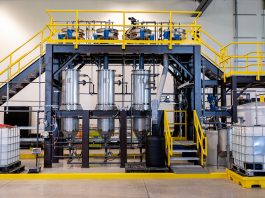A research team, including experts from the University of Bristol, has developed a cutting-edge algorithm for quantum computers that looks to enhance the efficiency of batteries and solar cells.
Collaborating with quantum start-up, Phasecraft and Google Quantum AI, the researchers’ quantum computing algorithm has revealed properties of electronic systems that could make a range of green technologies even more environmentally friendly.
The breakthrough signifies an essential advancement toward using quantum computers to identify low-energy properties of strongly correlated electronic systems that classical computers cannot solve.
Their novel algorithm is the first able to observe ground-state properties of the Fermi-Hubbard model on a quantum computer – a model that can reveal precious information into electronic and magnetic properties of materials.
The research paper, ‘Observing ground-state properties of the Fermi-Hubbard model using a scalable algorithm on a quantum computer,’ was published in Nature Communications.
What is the Fermi-Hubbard model?
Modelling quantum computers in this way has a plethora of potential benefits, such as aiding in designing new materials that could be employed to design more effective batteries and solar cells or even for high-temperature superconductors. However, achieving such feats is beyond even the capacity of the world’s most powerful supercomputers.
The Fermi-Hubbard model is recognised as a leading benchmark for near-term quantum computers due to it being the simplest materials system that includes non-trivial correlations beyond what is attained by classical methods. Producing the lowest-energy (ground) state of the Fermi-Hubbard model allows the user to calculate the vital physical properties of the model.
Pushing quantum computing to unprecedented levels
Previously, experts have only managed to solve small, highly simplified Fermi-Hubbard instances on quantum computers. By leveraging a new, highly efficient algorithm and advanced error-mitigation techniques, they performed an experiment that was four times larger and contained ten times more quantum gates than anything previously recorded.
Ashley Montanaro, Professor of Quantum Computation at the University of Bristol and Phasecraft co-founder, commented: “The Fermi-Hubbard instance in this experiment represents a crucial step towards solving realistic materials systems using a quantum computer.
“We succeeded by developing the first truly scalable algorithm that anyone has managed to implement for the Fermi-Hubbard model. That’s particularly exciting because it suggests that we will be able to scale our methods in order to leverage more powerful quantum computers as the hardware improves.”
Ryan Babbush, Head of Quantum Algorithms at Google AI, said: “We are delighted to see this experiment designed and executed by Phasecraft, representing one of the largest digital fermionic simulations to date, and also one of the largest variational algorithms to date, performed on Google’s quantum computing hardware. The scalability of their approach derives from being state-of-the-art in terms of both error-mitigation and algorithm compilation for near-term quantum hardware.”
Stasja Stanisic, Senior Quantum Engineer at Phasecraft, the paper’s lead author, concluded: “This experiment represents a new milestone. It tells us what today’s quantum computers are capable of when we apply the best algorithmic technology available. We can build on this work to develop better algorithms and better encodings of realistic problems for today’s devices.”









